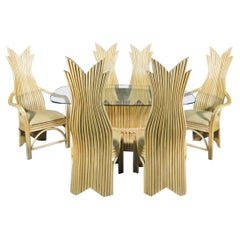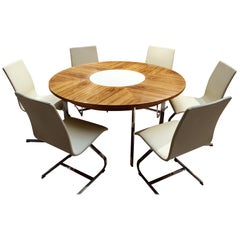Merrow Associates Dining Room Sets
to
Height
to
Width
to
Depth
to
1
1
1
1
1
1
1
1
1
1
1
1
1
1
1
1
1
8
25
15
14
12
Creator: Merrow Associates
Richard Young Merrow Associates A Chrome Dining Table & a Set of 8, 160z Chairs
By Merrow Associates
Located in London, GB
Richard Young for Merrow Associates.
A chrome dining table with the original smoked glass circular top and a set of eight rare 160Z Merrow chairs which are arguably the best-lookin...
Category
1970s English Mid-Century Modern Vintage Merrow Associates Dining Room Sets
Materials
Steel, Chrome
Related Items
McGuire Style Rattan Dining Table & Chairs
Located in Brooklyn, NY
Odd rattan bases with woven faux leather seats with high backs. Table has rattan base with oval glass top.
2 arm chairs measure 49" H x 26 1/4" W x 26" D. Seat height 18 1/2". 6 ...
Category
20th Century Post-Modern Merrow Associates Dining Room Sets
Materials
Rattan
Richard Young for Merrow Associates Mid Century Rosewood and Chrome Serving Cart
By Merrow Associates, Richard Young
Located in Countryside, IL
Richard Young for Merrow Associates Mid Century Rosewood and Chrome Serving Cart
This serving cart measures: 29.5 wide x 18.25 deep x 26.5 inches high
All pieces of furniture can b...
Category
1970s English Mid-Century Modern Vintage Merrow Associates Dining Room Sets
Materials
Chrome
$3,695
H 26.5 in W 29.5 in D 18.25 in
Vintage 1960's Merrow Associates Round Dining Table
By Merrow Associates
Located in London, GB
Vintage 1960's Rosewood Merrow Associates round dining table set on a chrome base.
Dimensions:
Width: 137 cm
Height: 75 cm
Category
20th Century British Mid-Century Modern Merrow Associates Dining Room Sets
Materials
Chrome
Richard Young - Merrow Associates Rosewood & Chromed Steel Tiered MCM Bar Cart
By Merrow Associates, Richard Young
Located in Philadelphia, PA
Designed by English designer Richard Young, this bar cart was made by the company he founded, Merrow Associates, in the 1970s in the UK. Its construction is mainly of two loops of so...
Category
1970s English Mid-Century Modern Vintage Merrow Associates Dining Room Sets
Materials
Chrome
$2,900
H 26.5 in W 30 in D 17.75 in
Clean Lined Glass and Chrome Dining Table or Desk
Located in Atlanta, GA
Clean Lined Glass and Chrome Dining Table or Desk
Category
1960s American Mid-Century Modern Vintage Merrow Associates Dining Room Sets
Materials
Chrome
Vintage Coffee Table by Merrow Associates
By Merrow Associates, Richard Young
Located in London, GB
A very stylish and iconic vintage coffee table by Merrow Associates. This was made in England, it was designed by Richard Young and it dates from the early 1970’s.
The quality is su...
Category
1970s British Mid-Century Modern Vintage Merrow Associates Dining Room Sets
Materials
Chrome
Richard Young For Merrow Associates Chrome & Glass Dining Table
By Merrow Associates
Located in Tonbridge, Kent
Designed by Richard Young, proprietor of high end British manufacturer Merrow Associates in 1970’s, this highly decorative dining table features a large stunning rectangular clear to...
Category
Late 20th Century British Bauhaus Merrow Associates Dining Room Sets
Materials
Chrome
$1,707 Sale Price
20% Off
H 28.15 in W 77.96 in D 31.11 in
Rare Pantonova Dining Set by Verner Panton 1971, Chrome, Glass Table, Six Chairs
By Verner Panton, Fritz Hansen
Located in Kansas City, MO
Pantonova dining table and chairs designed by Verner Panton for Fritz Hansen, Denmark, 1971. The black and white check fabric was updated two years ag...
Category
1970s Danish Scandinavian Modern Vintage Merrow Associates Dining Room Sets
Materials
Chrome
$39,850
H 30 in W 25.25 in D 23 in
Gary Gutterman Stainless Steel Dining Table and Chair Set, Axius Designs, 1970
By Gary Gutterman
Located in Chicago, IL
Stainless steel dining set designed by Gary Gutterman for Axius Designs in 1970s. Set includes glass top dining table and 8 chairs. All original and in very good condition.
Category
1970s American Mid-Century Modern Vintage Merrow Associates Dining Room Sets
Materials
Stainless Steel
$9,500
H 29 in Dm 90 in
Walnut and Antique Nickel Dining Set with Four Dining Chairs
By Stephen Kenn
Located in Los Angeles, CA
Dining goods are one of the newest additions to Stephen Kenn's The Inheritance collection. A solid walnut and steel dining table with simple and modern lines, with a set of four matc...
Category
2010s American Modern Merrow Associates Dining Room Sets
Materials
Steel
Mid-Century Modern Dining Room Sideboards Table Chairs Sets by Paolo Buffa
By Paolo Buffa
Located in Vigonza, Padua
Description: Mid-Century modern dining room sets by Paolo Buffa (La Permanente Mobili Cantu)
consists of: long sideboard, small sideboard, table with glass top and four chairs. Orig...
Category
1940s Italian Mid-Century Modern Vintage Merrow Associates Dining Room Sets
Materials
Brass, Gold Leaf
$21,938 / set
H 37.01 in W 86.62 in D 35.44 in
Mid-Century Six Chair Dining Set
Located in Brooklyn, NY
This uniquely sized vintage dining table comes matched with a set of six vintage dining chairs. Wonderful Mid-Century design exemplified with the stunning sculpted legs shared by bot...
Category
1960s Mid-Century Modern Vintage Merrow Associates Dining Room Sets
Materials
Wood
Previously Available Items
Vintage Rosewood Dining Table and Chairs by Richard Young for Merrow Associates
By Merrow Associates, Richard Young
Located in Highclere, Newbury
A Classic and iconic British Mid-Century Modernist dining set comprising a 6 seater circular dining table and 6 cream leather and chrome cantilever chairs dating from the late 1960s....
Category
Mid-20th Century British Modern Merrow Associates Dining Room Sets
Materials
Chrome
H 29.14 in W 54.34 in D 54.34 in
Merrow Associates dining room sets for sale on 1stDibs.
Merrow Associates dining room sets are available for sale on 1stDibs. These distinctive items are frequently made of steel and are designed with extraordinary care. There are many options to choose from in our collection of Merrow Associates dining room sets, although beige editions of this piece are particularly popular. Many of the original dining room sets by Merrow Associates were created in the mid-century modern style in united kingdom during the 1970s. Prices for Merrow Associates dining room sets can differ depending upon size, time period and other attributes — on 1stDibs, these items begin at $9,757 and can go as high as $9,757, while a piece like these, on average, fetch $9,757.



